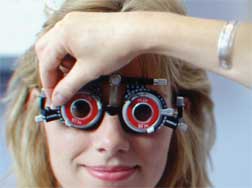Bangalore A new,
low-cost device developed at the Massachusetts Institute of Technology’s
Media Lab can diagnose
refractive defects of the eye in under two minutes
and promises to make much-needed eye care accessible to villagers who can’t
pay a visit to the optometrist.
The Near-Eye Tool for Refractive Assessment, or NETRA,
Sanskrit for ‘eye’, is a little device that can be clipped on to a phone
with the requisite software installed on it. With an array of lenslets made
of plastic, the device uses the phone display to run tests and generate a
prescription in less than two minutes.
Associate Professor at the Camera Culture Lab, Ramesh
Raskar, who led the project, said the device can be mass-produced for less
than $2 a piece and used to diagnose myopia, hypermetropia and astigmatism.
“Clinical trials are pending, but we have tested the device on 20 people and
the accuracy is well within permissible limits,” said Raskar, 40, who hails
from Nashik and visits India about once a year to attend the EmTech
conference organised by MIT’s Technology Review.
While Raskar himself has perfect vision, the project
took shape about a year ago when he was showing his wife one of the Camera
Culture Lab’s inventions — the Bokode, a barcode design with a simple
lenslet over the pattern. “She could see the pattern clearly with one eye,
but not with the other. Then it struck me that we could exploit the idea of
the Bokode, which is based on printed film, and use the optical system to
measure refractive error using a cellphone display and multiple lenslets,”
he said.
Ankit Mohan, a postdoctoral researcher in Raskar’s
lab, is also part of the project. Speaking to The Indian Express on phone,
Raskar said, “The two others in the team are from Brazil. Since all four of
us are from developing countries, this was a project close to our hearts.”
The academic paper by Raskar, Visiting Professor Manuel Oliveira, student
Vitor Pamplona and Mohan will be presented next month at the annual computer
graphics conference SIGGRAPH.
As of now, the NETRA can only be used with a
high-resolution cell phone display, but Raskar said he hoped that “though
not everyone can buy such a phone, a village shopkeeper may have one and it
can be used to provide eye care to everyone in the village”.
“We are working towards an NGO model now. The cost of
diagnosis is usually higher than the cost of delivering spectacles to those
with faulty vision. Now that cost can be minimised. The point of this device
is to provide an optometric solution where you don’t need trial lenses and a
reading chart,” he added.
The Camera Culture Lab is exploring a collaboration
with Hyderabad-based LV Prasad Eye Institute. “When Director Balasubramaniam
visited MIT a few months ago, we realised that the device was perfectly
suited to a developing country scenario. It’s an ideal collaboration,”
Raskar said.
Other projects at the lab include a 3-D display that
requires no glasses, a new CAT scan machine and, hold your breath, a camera
that can look around the corner and size up objects not visible otherwise —
a tool that could be useful in medical procedures like endoscopy.




